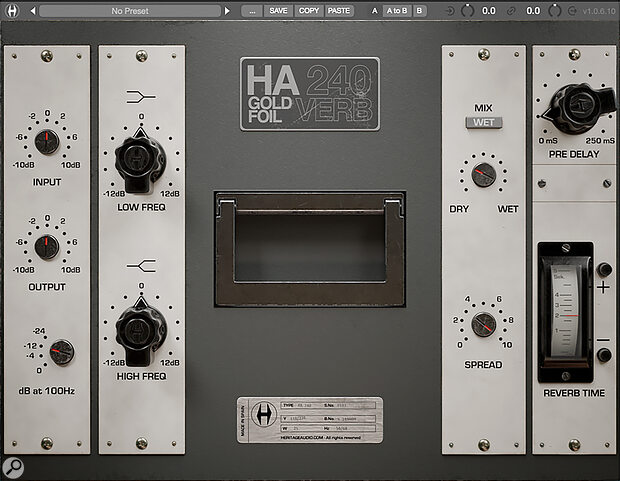Heritage Audio are well‑known for their high‑quality preamps and analogue outboard gear, but having hired programmers to develop for their i73 range of audio interfaces, they also found themselves in a good position to start developing their own plug‑ins — and while their new HA 240 Gold Foil Verb, based on the EMT 240 plate reverb, is not their first plug‑in, it’s the first to come to us for review. Available for Mac and Windows operating systems and supporting VST3, AU and AAX formats, the authorisation process requires an iLok account.
The original EMT 240 was designed as a more compact and lighter alternative to the better‑known EMT 140, and used a gold‑foil plate in place of the steel plate used in the latter. This resulted in a rather different sound quality from that of the 140; the 240 is often described as sounding tighter with a less pronounced high end. Despite that, with the EQ wide open, it could still sound usefully brash on things such as snare drums. The maximum decay time is shorter than that of the 140 and doesn’t bloom in quite the same way but at the time of its manufacture, it stood up well against earlier digital reverbs, which tended to have quite a grainy character.
The HA 240 plug‑in can work as a mono, stereo or mono‑in/stereo‑out processor and has a photorealistic GUI, with controls for input and output levels, low and high shelving EQ with a cut/boost range of ±12dB, and a separate low‑cut filter that can be set in four steps to produce up to 24dB of cut at 100Hz. Pre‑delay was routinely created for plate reverbs using a separate tape machine, and in the HA 240 a variable pre‑delay control gives a continuously variable delay time of up to 250ms. A Dry/Wet balance control sits below a Wet button that when active produces a 100 percent wet sound for when using the plug‑in on a send bus. A Spread control offers a subtle adjustment to the stereo spread of the output, and the reverb time is shown via a pointer on a drum calibrated in seconds. The markings go up to four seconds but it’s possible to push the reverb time a little beyond that. Adjustment to the decay time is made either by dragging the pointer or by using the plus and minus buttons.
The HA 240 doesn’t quite have the same attack as a physical plate but... that was a deliberate design decision.
A number of good plug‑in manufacturers have taken on the EMT 240, Soundtoys being just one example, and the best of these capture the overall essence of the original EMT 240 gold‑foil plate sound. To my ears the HA 240 doesn’t quite have the same attack as a physical plate (plate reverbs are characterised by a very fast build‑up of reverb density), but once the dry sound is added that really doesn’t seem to matter — it sounds great. I did query this characteristic with the designers, though, and they told me that this was a deliberate design decision, intended to help preserve the clarity of the original sound’s attack. It seems to work. Used on drums, the HA 240 produces a classic plate‑style reverb tail without overdoing the inherent metallic edge that characterises traditional plates, and on reducing the decay time, the HA 240 responds just as it would when a physical damper is being applied to the plate.
Sounds Musical
We’re spoiled for choice with different reverb types today, but one of the benefits of a plate is that the added reverb doesn’t suggest any specific physical space — it just sounds musical. That’s exactly what you get here. HA 240’s character sits very naturally with instruments such as acoustic guitar or piano and of course vocals, and while the EMT 140 arguably remains the classic plate reverb sound, the HA 240 provides an alternative character that can definitely be musically useful.

